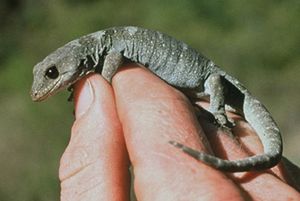Black-eyed gecko facts for kids
Quick facts for kids Black-eyed gecko |
|
|---|---|
 |
|
| Conservation status | |
| Scientific classification | |
| Genus: |
Mokopirirakau
|
| Species: |
kahutarae
|
| Synonyms | |
|
|
The black-eyed gecko (Mokopirirakau kahutarae) is a special type of lizard. It is also known as Whitaker's sticky-toed gecko. This gecko lives high up in the mountains of New Zealand's South Island. It was first discovered in 1970. It can live at amazing heights, up to 2,200 meters (about 7,200 feet) above sea level! This makes it New Zealand's highest-living lizard.
Contents
What Does the Black-Eyed Gecko Look Like?
The black-eyed gecko is a medium-sized lizard. Its back is usually olive green or grey. Its belly is white. It has 6 to 7 lighter stripes across its back. Its sides are speckled with small dots.
This gecko has very tiny body scales. Its toes are narrow and pointy. They look more like a tree-climbing gecko's toes than a ground-dwelling one's. The most unique thing about this gecko is its eyes. It has very noticeable eyebrows and super black eyes. Most other geckos have lighter eyes with fancy patterns. When you pick it up, it might make chirping sounds or squeal.
How Does This Gecko Behave?
The black-eyed gecko is a nocturnal animal. This means it is active at night. It can even be active when the temperature is as low as 7 degrees Celsius (45 degrees Fahrenheit).
During the day, it likes to warm up in the sun. It often basks on rocks near its hiding spot. But it is very shy! If it feels disturbed, it will quickly run away and hide.
Where Does the Black-Eyed Gecko Live?

The first black-eyed gecko was found in March 1970. It was in a group of Hutton's shearwater birds. This was on Mt Tarahaka in the Seaward Kaikoura Range. Scientists knew right away it was a new species.
For many years, they searched for more of these geckos. But they couldn't find any until 1983. Four more geckos were found about 30 kilometers (19 miles) away. This new spot was in the Kahutara Saddle area. The gecko's scientific name, kahutarae, comes from this place.
Since then, black-eyed geckos have also been found in the mountains of Nelson. They also live in the Lewis Pass area. They make their homes on rocky cliffs and outcrops. These areas are between 1,200 and 2,200 meters (about 3,900 to 7,200 feet) high. They can even survive in places where plants are patchy. These areas are often covered in snow during winter.
It is thought that these geckos might live in high, rocky places to escape from rats and mice. These animals are common at lower altitudes.
Is the Black-Eyed Gecko in Danger?
In 2012, New Zealand's Department of Conservation (DOC) looked at the black-eyed gecko. They decided it was "Nationally Vulnerable." This means it is at risk of becoming endangered in New Zealand.
This decision was made because there are only a few groups of these geckos left. The largest group has fewer than 500 individuals. Scientists believe their numbers will likely go down. They also noted that not much is known about this gecko. It is spread out in small numbers over a limited area.


